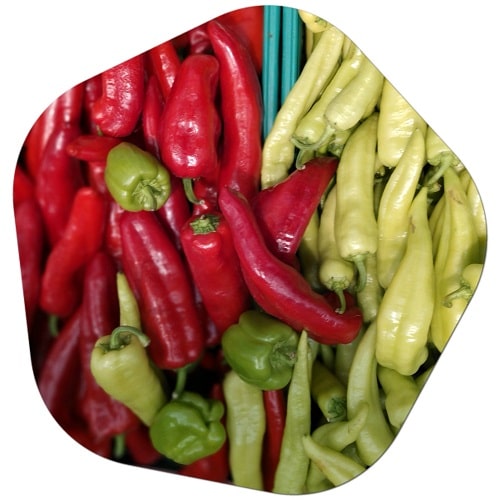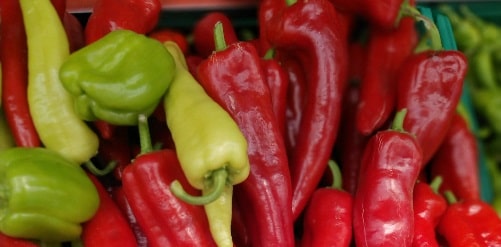Where are peppers grown in the US
Can peppers grow in America? Yes, peppers can definitely grow in America. In fact, peppers are widely cultivated across the United States, from commercial farms to backyard gardens. Peppers are a popular vegetable crop that can thrive in various climates, making them suitable for cultivation in different regions of the country. Whether you’re in the warmer southern states or the cooler northern states, you can successfully grow a variety of pepper types.
Peppers are grown in various states across the United States, as they are a popular vegetable crop that thrives in a range of climates. Here are some of the states where peppers are commonly grown:
- California: California is a major producer of peppers, including bell peppers, chili peppers, and sweet peppers. The state’s diverse climate allows for year-round production in different regions.
- Florida: Florida is known for its warm climate, making it suitable for growing peppers throughout much of the year. Bell peppers, chili peppers, and specialty varieties are commonly grown.
- New Mexico: New Mexico is famous for its chili pepper production, particularly varieties like Hatch green chiles. The state’s unique climate and soil contribute to the distinct flavor of New Mexican peppers.
- Texas: Texas is another significant producer of peppers, including bell peppers and various chili pepper varieties. The state’s warmer regions support pepper cultivation.
- Georgia: Georgia grows a variety of peppers, especially in its southern regions. Bell peppers, banana peppers, and jalapeños are commonly cultivated.
- Arizona: Arizona’s warm and arid climate allows for pepper production, including both sweet and hot varieties.
- North Carolina: Bell peppers, jalapeños, and other chili pepper varieties are grown in North Carolina’s climate.
- Ohio: Ohio’s temperate climate supports the cultivation of bell peppers, with the state being a significant producer.
- Michigan: Michigan’s short growing season limits pepper cultivation to the warmer months, but bell peppers and other varieties can still be grown successfully.
- South Carolina: Similar to North Carolina, South Carolina grows a variety of peppers in its climate.
- Louisiana: Louisiana is known for its spicy cuisine, and peppers like cayenne are commonly grown in the state.
- Pennsylvania: Bell peppers and other varieties are cultivated in Pennsylvania, with greenhouse production extending the growing season.
- Tennessee: Peppers, including bell and chili peppers, are grown in Tennessee’s climate.
- New Jersey: Peppers are among the vegetable crops grown in New Jersey, contributing to the state’s agricultural output.

These are just a few examples of states where peppers are grown in the United States. Peppers are a versatile crop that can be cultivated in various regions, from warmer southern states to cooler northern states, depending on the specific variety and growing techniques used.
When to plant pepper varieties in the USA?
The best time to plant pepper varieties in the USA can vary depending on the specific region and climate zone you are in. Peppers are warm-season crops that are sensitive to frost, so it’s important to consider the average last frost date in your area when deciding when to plant. Here are some general guidelines for planting pepper varieties in different regions of the USA:
- Southern States (e.g., Florida, Texas, Georgia): In the warmer southern states, where the growing season starts earlier, you can typically start planting pepper varieties outdoors in late winter to early spring. Transplants can be set out in the garden once the danger of frost has passed, which can be as early as February to April, depending on the specific region.
- Mid-Atlantic and Midwest States (e.g., North Carolina, Ohio, Pennsylvania): In these regions, it’s common to start pepper seeds indoors in late winter, around 8-10 weeks before the last expected frost date. Transplants can be set out in the garden in late spring, typically in April or May, after the last frost.
- Northeastern States (e.g., New York, New Jersey, Massachusetts): Similar to the Mid-Atlantic and Midwest states, starting pepper seeds indoors in late winter and transplanting in late spring after the last frost is recommended.
- Western States (e.g., California, Washington, Oregon): Depending on the specific microclimate of your area, you might have a longer growing season. You can start planting pepper seeds indoors earlier, around late winter, and set out transplants in late spring.
- Mountain States (e.g., Colorado, Utah): These regions often have shorter growing seasons due to higher elevations. Start pepper seeds indoors in early spring, around 10-12 weeks before the last frost date, and transplant after the last frost.

Keep in mind that these are general guidelines, and the specific planting times can vary based on the local climate, microclimates, and weather conditions in your area. To determine the optimal planting time for pepper varieties, consider:
- Your local average last frost date.
- The specific requirements of the pepper variety you’re growing (hot peppers vs. sweet peppers).
- Whether you’re starting seeds indoors or planting transplants directly in the garden.
You can use local gardening resources, seed packets, and extension offices to get more accurate information for your specific region and climate zone.
Pepper varieties grown in the United States
There are a wide variety of pepper varieties grown in the United States, ranging from sweet and mild to hot and spicy. Here are some popular pepper varieties that are commonly cultivated across the country:
Sweet Peppers:
- Bell Pepper: Perhaps the most recognizable sweet pepper, bell peppers come in various colors such as red, green, yellow, and orange. They are versatile in cooking and can be enjoyed raw or cooked.
- Italian Sweet Pepper (Corno di Toro): This variety has a tapered shape and a sweet, mild flavor. It’s often used in Mediterranean dishes.
- Cubanelle Pepper: A sweet pepper with a slightly spicy kick, often used in Hispanic cuisine for frying or stuffing.
- Pimento Pepper: These small, heart-shaped peppers are commonly used for making pimento cheese spreads and are also found in some olive preparations.
- Lipstick Pepper: With its pointed shape and vibrant color, the lipstick pepper is sweet and great for salads and roasting.
Hot Peppers:
- Jalapeño Pepper: A popular and widely used hot pepper with a medium level of heat. Jalapeños are often sliced, diced, or pickled.
- Serrano Pepper: Smaller and hotter than jalapeños, serrano peppers are commonly used in salsas and sauces.
- Anaheim Pepper: Named after the city in California, Anaheim peppers have mild to moderate heat and are often roasted and used in dishes like chiles rellenos.
- Cayenne Pepper: Known for its fiery heat, cayenne pepper is used in both culinary and medicinal applications.
- Habanero Pepper: One of the hottest pepper varieties, habaneros have a distinct fruity flavor along with intense heat.
- Ghost Pepper (Bhut Jolokia): Once considered the world’s hottest pepper, ghost peppers are extremely spicy and are often used sparingly in sauces and dishes.
- Scotch Bonnet Pepper: Commonly used in Caribbean cuisine, scotch bonnet peppers are fruity and very hot.
- Thai Chili Pepper: Small yet potent, Thai chili peppers add intense heat to Asian dishes.
- Poblano Pepper: Mildly spicy and versatile, poblano peppers are often used for making chiles rellenos or adding flavor to sauces.
- Tabasco Pepper: Used to make the famous Tabasco hot sauce, these peppers have a distinctive flavor and heat level.
These are just a few examples of the many pepper varieties grown in the United States. Whether you’re looking for a mild kick or a fiery explosion of flavor, there’s a pepper variety to suit your taste and culinary preferences. Varieties of peppers grown in America >>





